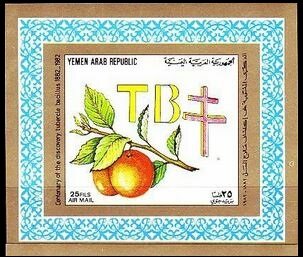Mini Sheet: Oranges (Yemen, Arab Republic 1982)
Oranges (Yemen, Arab Republic 1982)
01 August (Yemen, Arab Republic ) within release Centenary of the Discovery of the Tuberculosis Bacillus goes into circulation Mini Sheet Oranges face value 25 Yemeni fils
| Mini Sheet Oranges in catalogues | |
|---|---|
| Michel: | Mi: YE-AR 1739EB |
Mini Sheet is square format.
Also in the issue Centenary of the Discovery of the Tuberculosis Bacillus:
- Stamp - Bunch of grapes and flowers face value 75;
- Stamp - Cherries and flowers face value 100;
- Souvenir Sheet - Flowers and Robert Koch face value 4*125;
- Souvenir Sheet - Fruits and Robert Koch face value 4*100;
- Stamp - Lemons and flowers face value 125;
- Stamp - Oranges face value 25;
- Stamp - Pears face value 50;
- Stamp - Quince and flowers face value 60;
- Stamp - Apples and R.Kock face value 100;
- Stamp - Apricots and R.Kock face value 100;
- Mini Sheet - Bunch of grapes and flowers face value 75;
- Mini Sheet - Cherries and flowers face value 100;
- Stamp - Flowers and R.Kock face value 125;
- Stamp - Flowers and R.Kock face value 125;
- Stamp - Flowers and R.Kock face value 125;
- Stamp - Flowers and R.Kock face value 125;
- Mini Sheet - Lemons and flowers face value 125;
- Mini Sheet - Oranges face value 25;
- Mini Sheet - Pears face value 50;
- Stamp - Plums and R.Kock face value 100;
- Mini Sheet - Quince and flowers face value 60;
- Stamp - Raspberries and R.Kock face value 100;
Mini Sheet Oranges it reflects the thematic directions:
An anniversary is the date on which an event took place or an institution was founded in a previous year, and may also refer to the commemoration or celebration of that event. For example, the first event is the initial occurrence or, if planned, the inaugural of the event. One year later would be the first anniversary of that event. The word was first used for Catholic feasts to commemorate saints. Most countries celebrate national anniversaries, typically called national days. These could be the date of independence of the nation or the adoption of a new constitution or form of government. The important dates in a sitting monarch's reign may also be commemorated, an event often referred to as a "Jubilee".
In botany, a fruit is the seed-bearing structure in flowering plants (also known as angiosperms) formed from the ovary after flowering. Fruits are the means by which angiosperms disseminate seeds. Edible fruits, in particular, have propagated with the movements of humans and animals in a symbiotic relationship as a means for seed dispersal and nutrition; in fact, humans and many animals have become dependent on fruits as a source of food. Accordingly, fruits account for a substantial fraction of the world's agricultural output, and some (such as the apple and the pomegranate) have acquired extensive cultural and symbolic meanings. In common language usage, "fruit" normally means the fleshy seed-associated structures of a plant that are sweet or sour, and edible in the raw state, such as apples, bananas, grapes, lemons, oranges, and strawberries. On the other hand, in botanical usage, "fruit" includes many structures that are not commonly called "fruits", such as bean pods, corn kernels, tomatoes, and wheat grains. The section of a fungus that produces spores is also called a fruiting body.
Flora is the plant life occurring in a particular region or time, generally the naturally occurring or indigenous—native plant life. The corresponding term for animal life is fauna. Flora, fauna and other forms of life such as fungi are collectively referred to as biota. Sometimes bacteria and fungi are also referred to as flora, as in the terms gut flora or skin flora.



